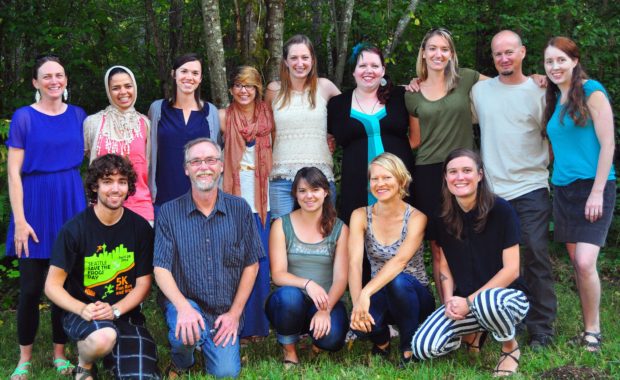
During an MES fieldtrip to the Elwha River, Carri (purple raincoat), talked with MES students and adjunct faculty Sarah Hamman (blue raincoat, also an SPP partner!). Photo by Shauna Bittle.
While reading a draft of the newsletter this quarter, I was overwhelmed by memories of SPP students past, inspired by SPP students present, and could barely contain my excitement about meeting the SPP students of the future! One of the great benefits of being the Co-Director on the Evergreen side of the SPP partnership (SPP is a partnership between The Evergreen State College and the Washington Department of Corrections) is interacting with our phenomenal undergraduate and graduate students.

During the first national meeting of SPP programs in 2012, Evan Hayduk and Carri LeRoy talk during a tour of Cedar Creek Corrections Center. Photo by Shauna Bittle.
I was able to cultivate particularly strong relationships with SPP graduate students while I spent three years as a faculty member in Evergreen’s Graduate Program on the Environment (MES) and had the distinct pleasure of mentoring sixteen thesis students. Of these students, half of them also worked as SPP Graduate Research Assistants, and four of them did their thesis projects on SPP. It was through many months of collaborative learning about their thesis research that I really got to know these students and their strengths and passions. They are inspiring individuals! Many of them enrolled in the MES program and moved across the country with the hope of being able to work for SPP. The MES program’s interdisciplinary curriculum and opportunities to do thesis projects that blend natural and social sciences make it an ideal partner for SPP. We like to think of SPP as a fantastic example of the three pillars of sustainability in action (environmental stewardship, economic cost saving, and social justice), so it is easy to choose aspects of the program to study from many angles. We are grateful for the dedication, enthusiasm, and time SPP Graduate Research Assistants put into their work for SPP. Their work is clearly appreciated by SPP staff, WA Corrections employees, incarcerated students, their peers, and outside agencies (as evidenced by the articles written in this issue of our newsletter). Our students have gone on to pursue PhDs and do excellent work after graduation for federal, state, and non-profit agencies. Evergreen students are truly a force to be reckoned with, and our SPP graduates are an elite group! I thank all of you (past, present, and future) for your contributions to SPP!

















 Graduation brings an end to student-staff employment. Each coordinator trains their successor, which is as much about introducing them to the culture and ways of thinking as it is about program policy and protocols. Each turnover is bittersweet. We have to say good-bye to someone we have relied on and invested in, and it is painful to see them go.! At the same time, we get to welcome someone new, and their fresh perspectives helps SPP to continually improve; we can’t get stale! Also, there is the satisfaction of seeing SPP alumni go on to new and valuable endeavors, and we take pride in supporting their ongoing careers and aspirations.
Graduation brings an end to student-staff employment. Each coordinator trains their successor, which is as much about introducing them to the culture and ways of thinking as it is about program policy and protocols. Each turnover is bittersweet. We have to say good-bye to someone we have relied on and invested in, and it is painful to see them go.! At the same time, we get to welcome someone new, and their fresh perspectives helps SPP to continually improve; we can’t get stale! Also, there is the satisfaction of seeing SPP alumni go on to new and valuable endeavors, and we take pride in supporting their ongoing careers and aspirations.










